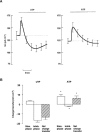Differential effects of UTP and ATP on ion transport in porcine tracheal epithelium
- PMID: 10807675
- PMCID: PMC1572082
- DOI: 10.1038/sj.bjp.0703324
Differential effects of UTP and ATP on ion transport in porcine tracheal epithelium
Abstract
Isolated segments of porcine tracheal epithelium were mounted in Ussing chambers, current required to maintain transepithelial potential difference at 0 mV (short circuit current, I(SC)) was monitored and effects of nucleotides upon I(SC) were studied. Mucosal UTP (100 microM) evoked a transient rise in I(SC) that was followed by a sustained fall below basal I(SC) maintained for 30 min. Mucosal ATP (100 microM) also stimulated a transient rise in I(SC) but in contrast to UTP did not inhibit basal I(SC). Submucosal UTP and ATP both transiently increased I(SC). UTP-prestimulated epithelia were refractory to ATP but prestimulation with ATP did not abolish the response to UTP. The epithelia thus appear to express two populations of apical receptors allowing nucleotides to modulate I(SC). The UTP-induced rise was reduced by pretreatment with either bumetanide (100 microM), diphenylamin-2-carboxylic acid (DPC, 1 mM), or Cl(-) and HCO(3)(-)-free solution whilst the fall was abolished by amiloride pretreatment. Thapsigargin (0.3 microM) abolished the UTP-induced increase in I(SC) but not the subsequent decrease. Staurosporine (0.1 microM) inhibited basal I(SC) and blocked UTP-induced inhibition of I(SC). Inhibitors of either protein kinase C (PKC) (D-erythro sphingosine) or PKA (H89) had no effect. This study suggests that UTP stimulates Cl(-) secretion and inhibits basal Na(+) absorption. ATP has a similar stimulatory effect, which may be mediated by activation of P2Y(2) receptors and an increase in [Ca(2+)](in), but no inhibitory effect, which is likely mediated by activation of a pyrimidine receptor and possible inhibition of a protein kinase other than PKC or PKA.
Figures





Similar articles
-
Differential regulations between adenosine triphosphate (ATP)- and uridine triphosphate-induced Cl(-) secretion in bovine tracheal epithelium. Direct stimulation of P1-like receptor by ATP.Am J Respir Cell Mol Biol. 2001 Sep;25(3):370-6. doi: 10.1165/ajrcmb.25.3.4382. Am J Respir Cell Mol Biol. 2001. PMID: 11588016
-
Effect of luminal nucleotides on Cl- secretion and Na+ absorption in distal bronchi.Pflugers Arch. 1999 Oct;438(5):621-7. doi: 10.1007/s004249900096. Pflugers Arch. 1999. PMID: 10555558
-
Inhibition of amiloride-sensitive epithelial Na(+) absorption by extracellular nucleotides in human normal and cystic fibrosis airways.Am J Respir Cell Mol Biol. 2000 Dec;23(6):755-61. doi: 10.1165/ajrcmb.23.6.4207. Am J Respir Cell Mol Biol. 2000. PMID: 11104728
-
Control of epithelial transport via luminal P2 receptors.Am J Physiol Renal Physiol. 2003 Mar;284(3):F419-32. doi: 10.1152/ajprenal.00075.2002. Am J Physiol Renal Physiol. 2003. PMID: 12556361 Review.
-
Recent developments in the classification and functional significance of receptors for ATP and UTP, evidence for nucleotide receptors.Life Sci. 1992;50(22):1657-64. doi: 10.1016/0024-3205(92)90420-t. Life Sci. 1992. PMID: 1316981 Review.
Cited by
-
ENaC, renal sodium excretion and extracellular ATP.Purinergic Signal. 2009 Dec;5(4):481-9. doi: 10.1007/s11302-009-9150-6. Epub 2009 Mar 21. Purinergic Signal. 2009. PMID: 19306075 Free PMC article.
-
ENaCs and ASICs as therapeutic targets.Am J Physiol Cell Physiol. 2012 Apr 1;302(7):C943-65. doi: 10.1152/ajpcell.00019.2012. Epub 2012 Jan 25. Am J Physiol Cell Physiol. 2012. PMID: 22277752 Free PMC article. Review.
-
Characteristics of Cl- uptake in rat alveolar type I cells.Am J Physiol Lung Cell Mol Physiol. 2009 Nov;297(5):L816-27. doi: 10.1152/ajplung.90466.2008. Epub 2009 Aug 14. Am J Physiol Lung Cell Mol Physiol. 2009. PMID: 19684200 Free PMC article.
-
Lipopolysaccharide modifies amiloride-sensitive Na+ transport processes across human airway cells: role of mitogen-activated protein kinases ERK 1/2 and 5.Pflugers Arch. 2010 Feb;459(3):451-63. doi: 10.1007/s00424-009-0717-4. Epub 2009 Oct 13. Pflugers Arch. 2010. PMID: 19823867 Free PMC article.
-
Adenosine-evoked Na+ transport in human airway epithelial cells.Br J Pharmacol. 2006 Sep;149(1):43-55. doi: 10.1038/sj.bjp.0706822. Epub 2006 Jul 31. Br J Pharmacol. 2006. PMID: 16880767 Free PMC article.
References
-
- ANDERSON M.P., GREGORY R.J., THOMPSON S., SOUZA D.W., PAUL S., MULLIGAN R.C., SMITH A.E., WELSH M.J. Demonstration that CFTR is a chloride channel by alteration of its anion selectivity. Science. 1991;253:202–207. - PubMed
-
- CHRISTOFFERSEN G.R.J., SKIBSTED L.H. Calcium ion activity in physiological salt solutions: influence of anions substituted for chloride. Comp. Biochem. Physiol. 1975;A52:317–322. - PubMed
Publication types
MeSH terms
Substances
LinkOut - more resources
Full Text Sources
Miscellaneous

